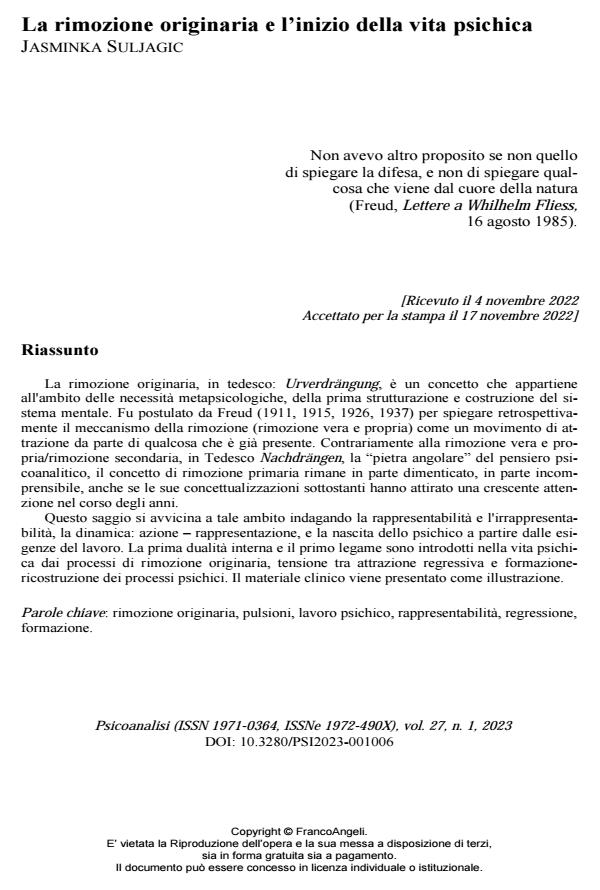Primal repression and the origin of mental life
Journal title PSICOANALISI
Author/s Jasminka Suljagic
Publishing Year 2023 Issue 2023/1 Language Italian
Pages 15 P. 83-97 File size 192 KB
DOI 10.3280/PSI2023-001006
DOI is like a bar code for intellectual property: to have more infomation
click here
Below, you can see the article first page
If you want to buy this article in PDF format, you can do it, following the instructions to buy download credits

FrancoAngeli is member of Publishers International Linking Association, Inc (PILA), a not-for-profit association which run the CrossRef service enabling links to and from online scholarly content.
Primal repression, D.: Urverdrängung, is a concept belonging to the realm of metapsy-chological necessities, of the first structuralisation and construction of the mental system. It was postulated by Freud (1911, 1915, 1926, 1937) to retrospectively explain the mechanism of repression (repression proper) as a movement of attraction by something which is already there. Contrary to repression proper/secondary repression, D.: Nachdrängen, the “cornersone” of psychoanalytic thinking, the concept of primal repression stays partly forgotten, partly in-comprehensible, even though its underlying conceptualisations have been attracting increased attention over the years. This paper approaches that realm by investigating representability and unrepresentable, dynamic: action – representation, and the birth of psychic from the requirements of work. The first internal duality and the first bond are introduced into psychic life by the processes of pri-mal repression, a tension between regressive attraction and the formation-reconstruction of psychic processes. Clinical material is presented as an illustration.
Keywords: primal repression, drives, psychic work, representability, regression, formation.
- Aisenstein M. (2010). The mysterious leap of the somatic into the psyche. In: Psychosomatic Today, A Psychoanalytic Perspective (ed. by Aisenstein, M. and Rappoport de Aisemberg, E.). London: Karnac Books.
- Botella C., Botella, S. (2005). The Work of Psychic Figurability. Mental States without Representation. London: Brunner-Routledge.
- Chervet B. (2017). Intimacy within analytic sessions. Panel presented at the IPA Congress in Buenos Aires, 2017.
- Freud S. (1887-1904). Briefe an Wilhelm Fliess (trad. it. Lettere a Wilhelm Fliess. Torino: Bollati Borin ghieri, 1986).
- Freud S. (1895). Entwurf einer Psychologie (trad. it. Progetto di una psicologia. In: OSF, vol. 2. Torino: Bollati Boringhieri, 1968).
- Freud, S. (1897). Draft M. The Architecture of Hysteria, May 25, 1897. The Complete Letters of Sigmund Freud to Wilhelm Fliess, 1887-1904 42: 246-248.
- Freud S. (1899). Traumdeutung (trad. it. L’interpretazione dei sogni. In: OSF, vol. 3. Torino: Bollati Boringhieri, 1966).
- Freud S. (1905). Drei Abhandlungen zur Sexualtheorie (trad. it. Tre saggi sulla teoria sessuale. In: OSF, vol. 4. Torino: Bollati Boringhieri, 1970.
- Freud S. (1910). Lettera di Sigmund Freud a Sándor Ferenczi, 6 dicembre 1910. In: The Correspondence of Sigmund Freud and Sándor Ferenczi, vol. 1. Cambridge: Harvard University Press.
- Freud S. (1910). Psychoanalytische Bemerkungen über einen autobiographisch beschrieben Fall von Paranoia (Dementia paranoides) (trad. it. Osservazioni psicoanalitiche su un caso di paranoia (dementia paranoides) descritto autobiograficamente. In: OSF, vol. 6. Torino: Bollati Boringhieri, 1974).
- Freud S. (1915a). Die Verdrängung (trad. it. La rimozione. In: OSF, vol. 8. Torino: Bollati Boringhieri, 1976).
- Freud S. (1915b). Das Unbewusste (trad. it. L’inconscio. In: OSF, vol. 8. Torino: Bollati Boringhieri, 1976).
- Freud S. (1920). Jenseits des Lustprinzips (trad. it. Al di là del principio di piacere. In: OSF, vol. 9. Torino: Bollati Boringhieri, 1977).
- Freud S. (1923). Das Ich und das Es (trad. it. L’Io e l’Es. In: OSF, vol. 9. Torino: Bollati Boringhieri, 1977).
- Freud S. (1924). Das ökonomische Problem des Masochismus (trad. it. Il problema economico del masochismo. In: OSF, vol. 10. Torino: Bollati Boringhieri, 1978).
- Freud S. (1925). Hemmung, Symptom und Angst (trad. it. Inibizione, sintomo, angoscia. In: OSF, vol. 10. Torino: Bollati Boringhieri, 1978).
- Freud S. (1937). Die endliche und die unendliche Analyse (trad. it. Analisi terminabile e interminabile. In: OSF, vol. 11. Torino: Bollati Boringhieri, 1979).
- Nancy J.L. (1993). The Birth to Presence. Stanford, California: Stanford University Press.
- Perelberg J.R. (2000). Dreaming and Thinking. London: Karnac.
- Rosenberg B. (2010). (Erotogenetic) Masochism and the pleasure principle. In: Reading French Psychoanalysis. London: Karnac.
Jasminka Suljagic, La rimozione originaria e l’inizio della vita psichica in "PSICOANALISI" 1/2023, pp 83-97, DOI: 10.3280/PSI2023-001006